Target Information
| Target General Information | Top | |||||
|---|---|---|---|---|---|---|
| Target ID |
T75517
(Former ID: TTDR00774)
|
|||||
| Target Name |
Glutamine amidotransferase (GMPS)
|
|||||
| Synonyms |
GMP synthetase; GMP synthase [glutamine-hydrolyzing]
Click to Show/Hide
|
|||||
| Gene Name |
GMPS
|
|||||
| Target Type |
Literature-reported target
|
[1] | ||||
| Function |
Involved in the de novo synthesis of guanine nucleotides which are not only essential for DNA and RNA synthesis, but also provide GTP, which is involved in a number of cellular processes important for cell division.
Click to Show/Hide
|
|||||
| BioChemical Class |
Carbon-nitrogen ligase
|
|||||
| UniProt ID | ||||||
| EC Number |
EC 6.3.5.2
|
|||||
| Sequence |
MALCNGDSKLENAGGDLKDGHHHYEGAVVILDAGAQYGKVIDRRVRELFVQSEIFPLETP
AFAIKEQGFRAIIISGGPNSVYAEDAPWFDPAIFTIGKPVLGICYGMQMMNKVFGGTVHK KSVREDGVFNISVDNTCSLFRGLQKEEVVLLTHGDSVDKVADGFKVVARSGNIVAGIANE SKKLYGAQFHPEVGLTENGKVILKNFLYDIAGCSGTFTVQNRELECIREIKERVGTSKVL VLLSGGVDSTVCTALLNRALNQEQVIAVHIDNGFMRKRESQSVEEALKKLGIQVKVINAA HSFYNGTTTLPISDEDRTPRKRISKTLNMTTSPEEKRKIIGDTFVKIANEVIGEMNLKPE EVFLAQGTLRPDLIESASLVASGKAELIKTHHNDTELIRKLREEGKVIEPLKDFHKDEVR ILGRELGLPEELVSRHPFPGPGLAIRVICAEEPYICKDFPETNNILKIVADFSASVKKPH TLLQRVKACTTEEDQEKLMQITSLHSLNAFLLPIKTVGVQGDCRSYSYVCGISSKDEPDW ESLIFLARLIPRMCHNVNRVVYIFGPPVKEPPTDVTPTFLTTGVLSTLRQADFEAHNILR ESGYAGKISQMPVILTPLHFDRDPLQKQPSCQRSVVIRTFITSDFMTGIPATPGNEIPVE VVLKMVTEIKKIPGISRIMYDLTSKPPGTTEWE Click to Show/Hide
|
|||||
| 3D Structure | Click to Show 3D Structure of This Target | PDB | ||||
| Cell-based Target Expression Variations | Top | |||||
|---|---|---|---|---|---|---|
| Cell-based Target Expression Variations | ||||||
| Drug Binding Sites of Target | Top | |||||
|---|---|---|---|---|---|---|
| Ligand Name: Xanthosine-5'-monophosphate | Ligand Info | |||||
| Structure Description | Human GMP synthetase in complex with XMP | PDB:2VXO | ||||
| Method | X-ray diffraction | Resolution | 2.50 Å | Mutation | No | [4] |
| PDB Sequence |
EGAVVILDAG
34 YGKVIDRRVR46 ELFVQSEIFP56 LETPAFAIKE66 QGFRAIIISG76 GPAPWFDPAI 93 FTIGKPVLGI103 CYGMQMMNKV113 FGGTVHKVFN130 ISVDNTCSLF140 RGLQKEEVVL 150 LTHGDSVDKV160 ADGFKVVARS170 GNIVAGIANE180 SKKLYGAQFH190 PEVGLTENGK 200 VILKNFLYDI210 AGCSGTFTVQ220 NRELECIREI230 KERVGTSKVL240 VLLSGGVDST 250 VCTALLNRAL260 NQEQVIAVHI270 DNGFMRKRES280 QSVEEALKKL290 GIQVKVINAA 300 HSFYNGTTTL310 PRISKTLNMT330 TSPEEKRKII340 GDTFVKIANE350 VIGEMNLKPE 360 EVFLAQGTLR370 PDLIESASLV380 ASGKAELIKT390 HHNDTELIRK400 LREEGKVIEP 410 LKDFHKDEVR420 ILGRELGLPE430 ELVSRHPFPG440 PGLAIRVICA450 EEPYICKDFP 460 ETNNILKIVA470 DFSASVKKPH480 TLLQRVKACT490 TEEDQEKLMQ500 ITSLHSLNAF 510 LLPIKTVGVQ520 GDCRSYSYVC530 GISSKDEPDW540 ESLIFLARLI550 PRMCHNVNRV 560 VYIFGPPVKE570 PPTDVTPTFL580 TTGVLSTLRQ590 ADFEAHNILR600 ESGYAGKISQ 610 MPVILTPLHF620 DRDPLQKQPS630 CQRSVVIRTF640 ITSDFMTGIP650 ATPGNEIPVE 660 VVLKMVTEIK670 KIPGISRIMY680 DLTSKPPGTT690 EWE
|
|||||
|
|
||||||
| Click to View More Binding Site Information of This Target with Different Ligands | ||||||
| Different Human System Profiles of Target | Top |
|---|---|
|
Human Similarity Proteins
of target is determined by comparing the sequence similarity of all human proteins with the target based on BLAST. The similarity proteins for a target are defined as the proteins with E-value < 0.005 and outside the protein families of the target.
A target that has fewer human similarity proteins outside its family is commonly regarded to possess a greater capacity to avoid undesired interactions and thus increase the possibility of finding successful drugs
(Brief Bioinform, 21: 649-662, 2020).
Human Tissue Distribution
of target is determined from a proteomics study that quantified more than 12,000 genes across 32 normal human tissues. Tissue Specificity (TS) score was used to define the enrichment of target across tissues.
The distribution of targets among different tissues or organs need to be taken into consideration when assessing the target druggability, as it is generally accepted that the wider the target distribution, the greater the concern over potential adverse effects
(Nat Rev Drug Discov, 20: 64-81, 2021).
Human Pathway Affiliation
of target is determined by the life-essential pathways provided on KEGG database. The target-affiliated pathways were defined based on the following two criteria (a) the pathways of the studied target should be life-essential for both healthy individuals and patients, and (b) the studied target should occupy an upstream position in the pathways and therefore had the ability to regulate biological function.
Targets involved in a fewer pathways have greater likelihood to be successfully developed, while those associated with more human pathways increase the chance of undesirable interferences with other human processes
(Pharmacol Rev, 58: 259-279, 2006).
Biological Network Descriptors
of target is determined based on a human protein-protein interactions (PPI) network consisting of 9,309 proteins and 52,713 PPIs, which were with a high confidence score of ≥ 0.95 collected from STRING database.
The network properties of targets based on protein-protein interactions (PPIs) have been widely adopted for the assessment of target’s druggability. Proteins with high node degree tend to have a high impact on network function through multiple interactions, while proteins with high betweenness centrality are regarded to be central for communication in interaction networks and regulate the flow of signaling information
(Front Pharmacol, 9, 1245, 2018;
Curr Opin Struct Biol. 44:134-142, 2017).
Human Similarity Proteins
Human Tissue Distribution
Human Pathway Affiliation
Biological Network Descriptors
|
|
|
There is no similarity protein (E value < 0.005) for this target
|
|
Note:
If a protein has TS (tissue specficity) scores at least in one tissue >= 2.5, this protein is called tissue-enriched (including tissue-enriched-but-not-specific and tissue-specific). In the plots, the vertical lines are at thresholds 2.5 and 4.
|


| KEGG Pathway | Pathway ID | Affiliated Target | Pathway Map |
|---|---|---|---|
| Purine metabolism | hsa00230 | Affiliated Target |

|
| Class: Metabolism => Nucleotide metabolism | Pathway Hierarchy | ||
| Drug metabolism - other enzymes | hsa00983 | Affiliated Target |

|
| Class: Metabolism => Xenobiotics biodegradation and metabolism | Pathway Hierarchy | ||
| Degree | 11 | Degree centrality | 1.18E-03 | Betweenness centrality | 2.08E-03 |
|---|---|---|---|---|---|
| Closeness centrality | 2.00E-01 | Radiality | 1.35E+01 | Clustering coefficient | 1.09E-01 |
| Neighborhood connectivity | 9.73E+00 | Topological coefficient | 1.24E-01 | Eccentricity | 13 |
| Download | Click to Download the Full PPI Network of This Target | ||||
| Drug Property Profile of Target | Top | |
|---|---|---|
| (1) Molecular Weight (mw) based Drug Clustering | (2) Octanol/Water Partition Coefficient (xlogp) based Drug Clustering | |
|
|
||
| (3) Hydrogen Bond Donor Count (hbonddonor) based Drug Clustering | (4) Hydrogen Bond Acceptor Count (hbondacc) based Drug Clustering | |
|
|
||
| (5) Rotatable Bond Count (rotbonds) based Drug Clustering | (6) Topological Polar Surface Area (polararea) based Drug Clustering | |
|
|
||
| "RO5" indicates the cutoff set by lipinski's rule of five; "D123AB" colored in GREEN denotes the no violation of any cutoff in lipinski's rule of five; "D123AB" colored in PURPLE refers to the violation of only one cutoff in lipinski's rule of five; "D123AB" colored in BLACK represents the violation of more than one cutoffs in lipinski's rule of five | ||
| Target Regulators | Top | |||||
|---|---|---|---|---|---|---|
| Target-interacting Proteins | ||||||
| Target Affiliated Biological Pathways | Top | |||||
|---|---|---|---|---|---|---|
| BioCyc | [+] 4 BioCyc Pathways | + | ||||
| 1 | Guanosine nucleotides de novo biosynthesis | |||||
| 2 | Superpathway of purine nucleotide salvage | |||||
| 3 | Purine nucleotides de novo biosynthesis | |||||
| 4 | Guanosine ribonucleotides de novo biosynthesis | |||||
| KEGG Pathway | [+] 3 KEGG Pathways | + | ||||
| 1 | Purine metabolism | |||||
| 2 | Drug metabolism - other enzymes | |||||
| 3 | Metabolic pathways | |||||
| Panther Pathway | [+] 1 Panther Pathways | + | ||||
| 1 | De novo purine biosynthesis | |||||
| Pathwhiz Pathway | [+] 2 Pathwhiz Pathways | + | ||||
| 1 | Glutamate Metabolism | |||||
| 2 | Purine Metabolism | |||||
| Reactome | [+] 1 Reactome Pathways | + | ||||
| 1 | Purine ribonucleoside monophosphate biosynthesis | |||||
| WikiPathways | [+] 1 WikiPathways | + | ||||
| 1 | Metabolism of nucleotides | |||||
| References | Top | |||||
|---|---|---|---|---|---|---|
| REF 1 | The Protein Data Bank. Nucleic Acids Res. 2000 Jan 1;28(1):235-42. | |||||
| REF 2 | Enzyme inhibitors: new and known polybrominated phenols and diphenyl ethers from four Indo-Pacific Dysidea sponges. J Nat Prod. 1995 Sep;58(9):1384-91. | |||||
| REF 3 | High-level production from a baculovirus expression system and biochemical characterization of human GMP synthetase. Protein Expr Purif. 1995 Aug;6(4):487-95. | |||||
| REF 4 | Substrate specificity and oligomerization of human GMP synthetase. J Mol Biol. 2013 Nov 15;425(22):4323-33. | |||||
If You Find Any Error in Data or Bug in Web Service, Please Kindly Report It to Dr. Zhou and Dr. Zhang.

